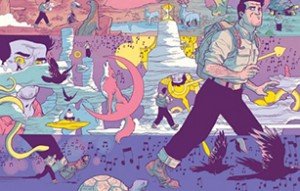Tale of Sand
In the late 60s, Jim Henson and Jerry Juhl collaborated on a screenplay called Tale of Sand, a darkly humorous, extremely ambitious work reminiscent of Time Piece in its imagery-heavy, stream-of-consciousness, deliberately nonsensical (in the Lewis Carroll sense of the word) flow and its surrealist depiction of what is essentially an existential crisis on screen, however much larger in scope to the former film, not only because it was intended to be feature-length but due to the sheer complexity of the visuals.
Like Time Piece, it’s more of a plunge into a bizarre fever dream than a narrative, and it’s probable that its weirdness and therefore probable lack of accessibility accompanied with how expensive it would be to produce led to its never having been made.
Read MoreMuppets for IBM
In 1965, IBM hired Jim Henson to make a number of short “industrial” films for their company, which were effectively intended as comedic shorts to break the tedium of long meetings. Later on, Jim would produce similar short pieces called the Muppet Meeting Films which could be used for any corporate client, and some of which were actually remakes of these early bits for IBM. I wasn’t able to get exact dates for all of these films, and some of them I know are from 1965, so I’ll be jumping backwards in the chronology a bit here, but it seemed like it would make most sense in this case to combine them all in one place.
What is likely the earliest of the set is a 4-part film starring Rowlf in which he writes home to his mom, documenting his first year as a salesdog for
Read MoreRipples, Wheels, Etc.
In 1967, Jim Henson made a one-minute short film for “Expo67,” which was a World’s Fair, in Montreal, Quebec. Called Ripples, it is reminiscent of Time Piece in its use of a stream-of-consciousness series of images that flow emotionally rather than logically, however in a much more compressed format, as well as the Bufferin ad in the previous post in its exploration of the human mind. Over the course of the minute, an architect played by Jon Stone–a producer who collaborated with Jim on a Cinderella pilot in 1965, and would later bring Jim on board to Sesame Street, and even later write The Monster at the End of This Book–drops a lump of sugar into his coffee, causing ripples in the glass, which fades to a shot of him by a lake, tossing pebbles into the water, each ripple bringing up images in his mind of architecture and art, moments of great progress throughout history and the then-modern day/future (illustrated via shots of NASA rockets and mission control centers), his home life, and his family. In a few short moments, it establishes ripples of connection between humanity, human progress and achievement, nature, and us.
Read More
More Short Films
Today, we’re starting off with two more short film projects that, remarkably–given how much work Time Piece was–Jim also did in 1965! The first is called Run, Run, which he shot outside his home in Greenwich, CT. It mainly depicts Jim’s two young daughters running around the fallen-leaf-strewn woods in October and ends with them running into their mom, Jane’s, open arms. I don’t have a great deal to say about it, but it’s a charming little piece, thanks to the score by Joe Raposo, who would later write the songs and music for Sesame Street, and like much of Jim’s short film work, it has a similar feel to the short pieces he’d shoot for Sesame Street of children playing and the like, with similarly gentle, lovely music. It also demonstrates some quietly inventive camera work, with the camera at first following the girls from a distance but eventually capturing their POV, bouncing up and down to recreate what they’re seeing as they dash along:
https://www.youtube.com/watch?v=MeyyOQJKay0
Read MoreTime Piece
Starting in mid-1964, Jim Henson began work on a side passion project that again speaks to the fact that puppetry not only wasn’t his only form of artistic expression but perhaps wasn’t even his favorite. And if that’s not necessarily the case, it at least underlines his lifelong desire to pursue other forms of storytelling and film-making. At this point, puppetry paid the bills, and he certainly enjoyed it, but he wanted more. He considered himself more of a visual artist and designer than a puppeteer (and interestingly, his later Muppet departures such as The Dark Crystal and Labyrinth would wed his love for complex worldbuilding through scenic design and art with the most advanced puppetry the world had ever seen), and in this 8-minute-long short film, which he originally called Time to Go before finally settling on Time Piece, he was able to fully indulge that part of himself.
Read More


